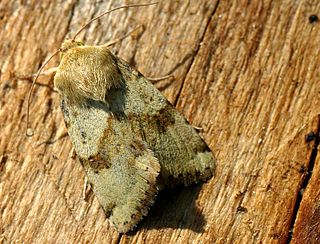Related Research Articles

Apamea remissa, the dusky brocade, is a species of moth of the family Noctuidae. It is distributed throughout Europe and Turkey, ranging across the Palearctic realm to Siberia, Manchuria and Japan. It has also been reported from Alaska.

Heliothis viriplaca, the marbled clover, is a moth of the family Noctuoidea. It is found in Europe and across the Palearctic to Central Asia then to Japan, Korea and Sakhalin. In the south, it penetrates to Kashmir and Myanmar. As a migratory moth, it also reaches areas in northern Fennoscandia in some years. North of the Alps, both indigenous and immigrant individuals occur in certain areas. The heat-loving species occurs mainly on dry grasslands, fallow land, heathlands and sunny slopes and slopes and the edges of sand and gravel pits.
Hexadactilia civilis is a moth of the family Pterophoridae. It is found in Queensland, Australia.

Hexadactilia trilobata is a moth of the family Pterophoridae described by Thomas Bainbrigge Fletcher in 1910. It is found in Australia in Queensland and New Guinea.

Sphenarches zanclistes is a moth of the family Pterophoridae that is found in Australia.
Batrachedra eremochtha is a species of moth of the family Batrachedridae. It is found in Australia.
Batrachedra megalodoxa is a species of moth of the family Batrachedridae. It is found in Australia.
Batrachedra mylephata is a species of moth of the family Batrachedridae. It is found in Australia.
Batrachedra plagiocentra is a species of moth of the family Batrachedridae. It is found in Australia.
Batrachedra sterilis is a species of moth of the family Batrachedridae. It is found in Australia.
Batrachedra volucris is a species of moth of the family Batrachedridae. It is found in Australia.
Izatha metadelta is a moth of the family Oecophoridae. It is endemic to New Zealand, where it is known from the North Island only. It is rare north of Waikato and the Bay of Plenty.

Izatha caustopa is a lichen tuft moth in the family Oecophoridae. It is endemic to New Zealand, where it is known very locally, and very infrequently, from the southern half of the North Island: two specimens collected in 2016 were the first seen for 30 years. It is classified as "Data Deficient" by the Department of Conservation.
Platyptilia isoterma is a moth of the family Pterophoridae. It is found in New Zealand.

Hypenodes humidalis, the marsh oblique-barred, is a moth in the family Erebidae. The species was first described by Henry Doubleday in 1850. It is found in most of Europe and across the Palearctic to Siberia.
Helcystogramma septella is a moth in the family Gelechiidae. It was described by Philipp Christoph Zeller in 1852. It is found in Malawi, South Africa, Tanzania and the Gambia.
Synchalara byrsina is a moth in the family Xyloryctidae. It was described by Edward Meyrick in 1907. It is found in India (Assam).
Synchalara minax is a moth in the family Xyloryctidae. It was described by Edward Meyrick in 1907. It is found in India (Assam).
Synchalara rhombota is a moth in the family Xyloryctidae. It was described by Edward Meyrick in 1907. It is found in Assam, India.
Imma synconista is a moth in the family Immidae. It was described by Edward Meyrick in 1918. It is found in Kanara, India.
References
- ↑ Synchalara at Markku Savela's Lepidoptera and Some Other Life Forms
- ↑ Journal of the Bombay Natural History Society 17: 743
| This article on a moth of the family Xyloryctidae is a stub. You can help Wikipedia by expanding it. |